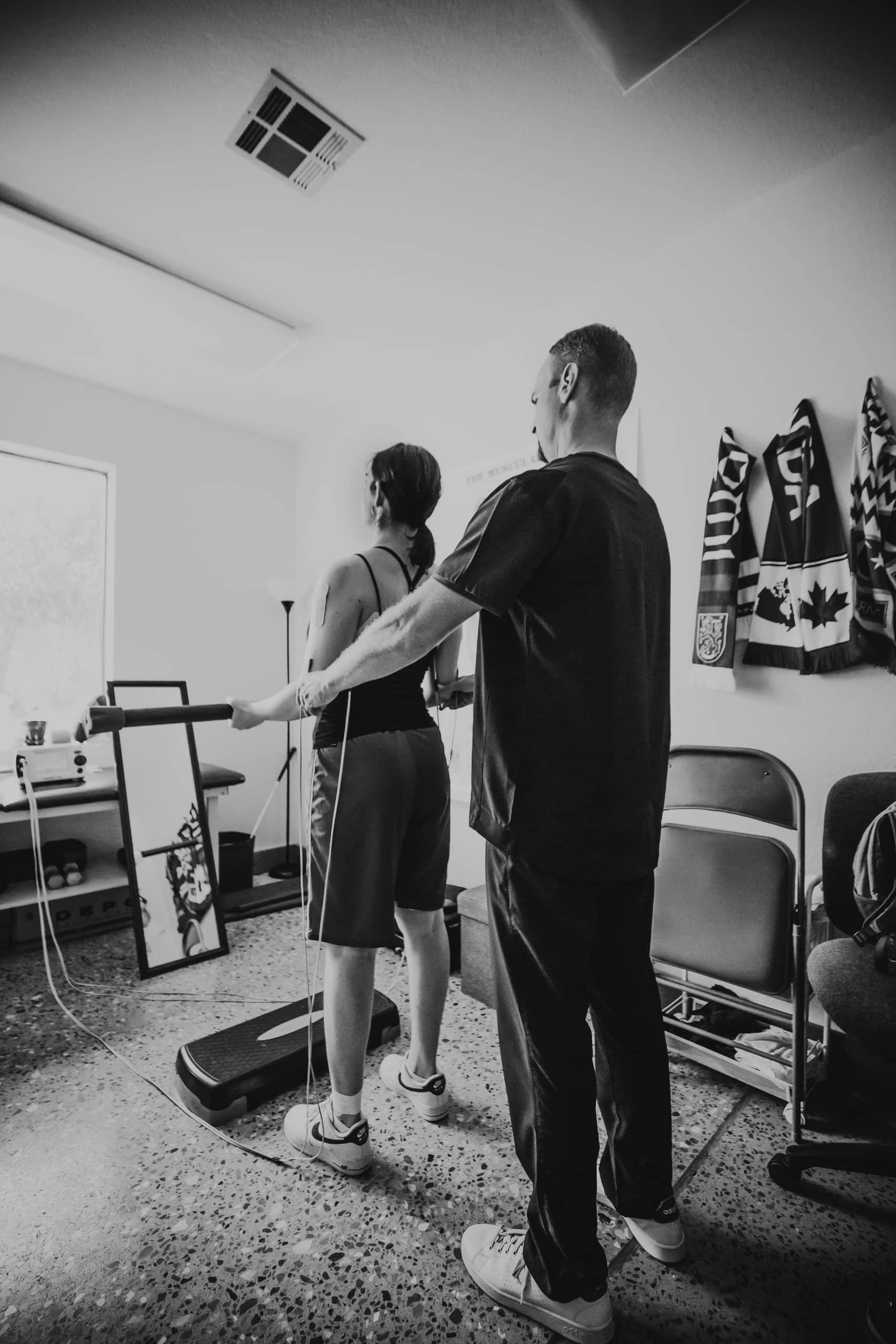There is no symptom more life-robbing to the CRPS sufferer than the constant, fiery, spirit-eroding pain. When you understand the mechanics behind the pain of CRPS, the pain makes perfect sense. Understanding the mechanics of your specific pain will bring you one step closer to hope.
Toxic Lesions Of The Disc(S) In The Neck
Since the cervical spine, brain stem, and autonomic nervous system are connected, we should start with the nature of the original injury. When most people picture a disc injury, they think of a disc that was herniated, or “squished,” and will show up as a big problem on an MRI. Sometimes, in their quest for answers, patients suffering from CRPS will undergo an MRI to rule out disc problems, because they often suffer from neck pain and/or frequent headaches, (although this pain may be overshadowed by the pain from CRPS). It is very common for nothing noteworthy to show up on the X-ray or MRI, and the spine to then be dismissed as a problem. Patients are told that their spinal problems are “normal” for their age, that is, everyone seems to have them at that age. However, spinal degeneration is never normal just because it is common.
Sometimes, some of the most devastating disc injuries, in terms of the lingering and devastating effects they have on the body, may go undetected by normal imaging. A study performed on people who died from non-spinal injuries following car accidents and had “normal” MRIs and X-rays after these accidents proved this. All these people were found to have disc injuries that had been missed. These injuries included small tears, bulges, and fractures where the vertebra meets the disc.29
You may wonder why these small injuries matter. How can such a thing contribute to the development of CRPS? I credit the developer of a technology I use in my practice called frequency-specific microcurrent (FSM), Carolyn McMakin, MA, DC, for first introducing me to the following information:
Deep inside the discs of the spine (in the “nucleus” of the disc) is a neurotoxic substance called phospholipase A2, or PLA2. A small tear in the cartilage of the disc or in the surrounding parts of the disc will cause PLA2 to leak out into the spinal fluid, thereby exposing the spinal cord to it.
This nasty little substance has been shown to be so neurotoxic and inflammatory when present outside the disc that it will destroy the nerves it comes in contact with. We call this a “toxic lesion” of the spine. The part of the cord most likely to be damaged by this neurotoxic substance (the thalamic tract) just happens to be a part of the spinal cord that carries deep pain information. Usually, because of the location of the disc and this part of the spinal cord, the cord is unfortunately exposed to high levels of PLA2. This causes what is called “central pain,” or “thalamic pain,” which mimics nerve pain exactly. Central pain is different from the pain caused by the actual injury site where the CRPS originated. It is whole body pain that may accompany the pain of CRPS. You may say, it is additional pain.
Please note: If you have pain or aching in your hands and feet, regardless of where the pain of CRPS first originated in your case, you need to pay attention here. A very important benchmark of central pain is aching in the hands and feet.
Substance P (Think P For Pain)
Nerve cells communicate with one another through messengers called “neurotransmitters.” Substance P is one of these messengers. It is a protein found in the brain and spinal cord that is associated with some inflammatory processes in the joints. Its function is to cause pain.
It essentially sends pain signals to the brain and spinal cord after it receives them from the sensory nerves. Interestingly enough, it has also been shown to be involved in increased stress and anxiety if elevated. The nerves that release Substance P have been shown to most likely be autonomic.30 Severe or prolonged injury of these autonomic nerves will cause pain in different ways: parts of the spinal cord will become hyperexcitable, making them very sensitive to toxic stimuli, and these in turn will lower the pain threshold in the patient.
Central Sensitization
If you suffer from CRPS, you should care a lot about central sensitization. It is based on the principle that basically, pain itself may change the way the central nervous system works (meaning the brain and spinal cord), causing more pain, and causing the patient to become hyper sensitive with less provocation. Sensitized patients are not only sensitive to things that would cause normal people pain, but also become sensitive to things that shouldn’t hurt. Sound familiar? Any kind of noxious (‘bad’) stimuli can trigger this reaction. Anything that hurts the skin, muscles, or organs. This pain can become constant and stick around even without provocation.
How tailbone or low back injuries May affect the neck
CRPS patients are all very fixated on the injury (or injuries) that triggered their CRPS. Whether it was something as innocent as a bunion surgery on the foot, or a devastating fracture, patients often live with what I refer to as the “if only” alternative story in their head. If only I didn’t fall. If only I was more careful that day. If only I left that neuroma in my foot alone…the pain from it doesn’t come CLOSE to the pain I live with now! Who can blame you? The truth is, though, that if not that injury, chances are that some other future injury would have eventually caused you to develop CRPS. Your body was most likely predisposed to it. The straw that broke the camel’s back is not responsible for breaking the camel’s back all by itself. It was merely the final action in a long chain of events leading up to it. Does this make sense?
One of the things that will put you most at risk for developing CRPS is cervical spine trauma, or low back and/or tailbone trauma. Think of the spine as a bridge with two stabilizing pillars on each end. If the low back or tailbone area becomes destabilized, the upper cervical spine will be affected too. In the spine, there is no such thing as an isolated injury. Every single part affects every single other part. Please do not mistake an injury to your spine with the same injury that triggered your CRPS (unless cervical spine or spinal cord trauma actually directly triggered it). In the vast majority, CRPS patients suffer from two separate physical injuries; spinal trauma (most often directly to the cervical spine, or indirectly to the low back/tailbone area(s)) that predisposes you to developing CRPS, and the injury (usually to a limb) that triggers it.
Many of my patients do not recall ever hurting their necks. However, these patients will often report injuries to their very low back and/or tailbone area(s). It may seem counterintuitive, as the atlas is at the very top of the spine, and the tailbone at the very bottom part of it. However, these patients have often suffered injuries (like a slip and fall on ice) or a tailbone fracture while giving birth. Think of the spine as a bridge with two stabilizing pillars at both ends. You cannot destabilize one pillar without it also affecting the other pillar. How exactly are these two areas directly connected?
We all have three membranes, called meninges, that surround the brain and spinal cord. these meninges are attached to the soft tissues and they form a three layer cover that seals in the Cerebro Spinal Fluid (CSF), much like clingwrap. The meninges protect these delicate structures. The meninges are attached to the bony structures at the foramen Magnum (the hole in the back of your skull where the spinal cord turns into the brainstem and attaches to the brain) and again at the sacrum (the flat triangular bone between your fifth Lumar vertebra and the tailbone). In between these two attachment points, the meninges are essentially free floating. If the coccyx is out of position, it will affect the way the sacrum moves. When the sacrum does not follow a normal moving pattern, it will create tension on these meninges, leading to dysfunction and misalignment of the upper cervical vertebrae in the spine.
While I don’t expect that you become an expert in anatomy, it is also important to know that the upper cervical spine and the very lower sacral area both give rise to the parasympathetic (rest and digest) nerves. If you want to stimulate the parasympathetic nervous system (i.e. the Vagus nerve), these are the areas that you will focus on. This is the case for CRPS patients, as it is vitally important to wake up the parasympathetic nerves and quiet the sympathetic nerves. For now, the most important thing I want you to take away from this information is that for CRPS patients, it is crucial that the bones in both your very upper cervical spine and your bones in the very lower spine (fifth Lumbar, Sacrum and Coccyx) are properly aligned.
While no exact percentages are known, it is my experience that the vast majority of patients who suffer from CRPS also suffered from upper cervical trauma or trauma to the very low back or tailbone area at some point. I would venture to put this number as high as 80 percent. For this reason, we are going to focus heavily on the involvement of these parts of the spine in CRPS.
It is important to note that the age of the injury is inconsequential. The mechanism of injury is often a car accident, but it can be attributed to many other mechanisms of injury, such as falls, birth trauma, or injury while under anesthesia. It is very important that you carefully examine your history from birth to adulthood when trying to understand what predisposed you to developing CRPS.
Cervical spine stenosis: does it make you vulnerable to damage?
Since the genetic cause of CRPS is such a popular one, I want to introduce a possible link between the shape of the spinal cord, which may be genetic, and the predisposition for spinal injury following an accident.
Spinal stenosis is a narrowing of the open canal that surrounds the spinal cord, or the foramina (bony opening) where the nerves exit the spine. This can put pressure on your spinal cord and the nerves that travel through the spine. Spinal stenosis occurs most often in the neck and lower back. While some people have no signs or symptoms, spinal stenosis can cause pain, tingling, muscle weakness, numbness, and problems with bladder or bowel function.
It is postulated that two popular medications often prescribed for fibromyalgia and CRPS, Lyrica and Cymbalta, actually address the symptoms of spinal cord pain rather than the indirect symptoms of fibromyalgia and/or CRPS. The EU (European Union) approved Lyrica for central spinal cord pain. Of course, these medications simply address the symptoms of central spinal cord pain, and not the anatomical problem.
There are two types of cervical stenosis: congenital and degenerative.
Congenital Stenosis Of The Cervical Spinal Canal
Some people are born with spinal stenosis. This is called congenital stenosis. They may not display any symptoms at a younger age, but having a narrow canal to begin with places them at risk for pain and injuries later in life. Even a seemingly minor neck injury can set them up to have pressure against the spinal cord. People born with a narrow spinal canal often develop problems later in life because the canal tends to become narrower due to aging; and the resulting changes in the spine. These changes often involve the formation of bone spurs (small bony growths caused by abnormal pressure in the spine) that put pressure on the spinal cord.
Degenerative Stenosis Of The Cervical Spinal Canal
Degeneration is the most common cause of spinal stenosis. Wear and tear on the spine from aging and from repeated stress and strain may cause many problems in the cervical spine. The intervertebral disc can begin to collapse, shrinking the space between vertebrae. Because of this collapse, bone spurs may form and protrude into the spinal canal, reducing the space available to the spinal cord.
Another common degenerative cause of stenosis is calcification of the posterior longitudinal ligament of the cervical spine. The posterior longitudinal ligament is situated within the vertebral canal. It extends along the posterior surfaces of the bodies of the vertebrae, or building blocks that form the spine, and goes down all the way to the sacrum, or the very lowest part of the spine.
All of these conditions may cause narrowing of the canal, leading to neurological symptoms and making you more vulnerable to spinal cord damage.
How do I know if my neck is the problem?
Recognizing neck or upper-back trauma in a CRPS patient can be tricky, since the majority of them either do not connect a past injury with their current diagnosis, or think that the injury was too insignificant to matter. Sometimes they may attribute it solely to the emotional stress that often accompanies a traumatic physical event, when both are actually to blame. I have seen this to be true especially in the case of domestic violence, where the emotional stress does play a role, but the physical injuries are dismissed as long healed.
There are a few clues that tend to point to spinal trauma as a culprit:
- A known past injury (or injuries) to the neck and/or upper back.
- Disc problems in the cervical spine, as seen on X-ray or MRI.
- Pain that does not respond well to medications or other treatments, such as massage therapy, physical therapy, surgery, trigger point injections, or exercise.
- Most will describe their extremities (hands and feet) as cold, aching, burning, or feeling as if they are “walking on glass.”
- Severe headaches.
- The pain will start out more locally but will eventually affect the entire spine, especially low back, and eventually the whole body.
- Digestive problems.
- “Foggy” feelings and feelings of confusion. Vision, hearing, speech, smell, balance, or taste may be affected.
- Pain in shoulders and upper back.
- Pain in the jaw/TMJ.
- Central pain.
Central Pain
What is central pain? WebMD defines it thus: “Central pain syndrome is characterized by a mixture of pain sensations, the most prominent being a constant burning. The steady burning sensation is sometimes increased by light touch. Pain also increases in the presence of temperature changes, most often cold temperatures. A loss of sensation can occur in affected areas, most prominently on distant parts of the body, such as the hands and feet. There may be brief, intolerable bursts of sharp pain on occasion.”
This pain is sharp, stabbing, tingling, shooting, or aching, and affected by temperature changes.
Weather Changes
Why does your body respond violently to changes in the weather? When patients suffer from central pain syndrome (CPS), their nervous systems actually change on several levels. In CPS, nociceptors (tiny pain receptors) and peripheral nerves become hypersensitive. Pain amplification in the spinal cord tends to increase, and the spinal cord’s ability to filter pain decreases. These changes become evident when the patient’s sensory nervous system is exposed to any change, such as cold or heat or a drop in barometric pressure, which occurs when rain is coming in or the wind is blowing. This causes the sensory nervous system to respond to that change. Tissues will also swell as a result, making the patient’s agony even worse.
How Can I Be Tested?
Please remember that while several tests may show problems in the neck, most doctors are not aware of the link between spinal problems and CRPS. If you want to get clear answers about the health of your spine, you should probably not do so in the hope that it will affect your doctor’s diagnosis or treatment of your CRPS. We do think it is very valuable information, especially on your road to understanding your condition and in searching for treatments that will work, and in finding eventual relief. Here are some of the tests that may uncover a link between your CRPS and cervical spine trauma.
Cervical X-Rays
Although X-rays can be useful to show overall damage and misalignment of the bones and other structures of the neck, it is important to have a trained eye look at those X-rays. Typically, misalignments of the bones (such as the bone shifting abnormally to the front or the back, or twisting out of position) and loss of the C-shaped curve (or lordotic curve) of the neck are seen as “normal degeneration” of the spine by most allopathic doctors. Health care professionals in the medical world are trained typically to not red-flag things that they often see and consider commonplace. Therefore, since degeneration is seen so often, it may be dismissed or only mentioned in passing.
A chiropractor is an example of a health care professional who has been trained with the philosophy that the integrity and overall health of the spine are crucial to the overall health of the person, and who will look for clues that other radiologists or doctors may dismiss. It is not a question of competency, but rather training and overall philosophies about health in general.
The clues to be looked for may include decreased disc space, misalignment of the spine, and degeneration of the spine, which is abnormal bone growth that the body uses to stabilize weakened areas, like casting a broken bone. These bones may also fuse together, or you could have a decreased curve of the neck called a hypolordotic curve, which appears as a straight neck or one curved in the wrong direction (think of forcefully straightening a banana). Lastly, you may have a misalignment of the upper first two bones in the neck, called the atlas and axis, or a misalignment of any of the bones in the neck.
In chiropractic, this is referred to as “subluxation.” The word “subluxation” is derived from the Latin word “lux,” or light, where “sub lux” means less than light, or less than perfect. Chiropractors, often viewed by the public as “bone poppers,” actually do so much more than that. They believe that the health of the spine is vital, given the importance of the central nervous system to the health of the overall individual.
The drawback of X-rays is that they are not good at showing the soft tissues—nerves, discs, and ligaments—and will not show the health or integrity of the disc clearly.
MRI
Magnetic resonance imaging allows health care professionals to take a look inside your body at the soft tissue structures of the spine, such as the discs. According to Carolyn R. McMakin (MA, DC), a doctor who specializes in the treatment of the neurological symptoms of this type of fibromyalgia and CRPS, MRI studies of patients whose symptoms stem from spinal trauma will often show disc bulges (imagine a water balloon being squashed between two bricks). These disc bulges will most commonly appear between the fifth and sixth cervical bones or the sixth and seventh cervical bones, and less often between the fourth and fifth cervical bones.
Again, be aware that the average radiologist or doctor will see these changes as part and parcel of the “normal” aging process. Most MRIs are taken while the patient is lying down, which removes some of the normal weight that your discs carry when you are in an upright position. Although it is hard to find an imaging center that performs it, it is possible to do standing MRIs in the flexion (bending the neck forward) and extension (bending the neck back) positions, which will often show disc bulges that are “hiding” on conventional views.
Functional MRI
Functional magnetic resonance imaging or functional MRI (fMRI) is an MRI procedure that measures brain activity by detecting associated changes in blood flow. fMRI is used more in the research world than the clinical world. Although this technology is still in its infancy and not widely used yet, we did feel that it deserved a mention.
Myelogram
A myelogram is an image that involves injecting contrast material by needle into the space around the spinal cord and nerve roots (the subarachnoid space) and then taking an image of it using a real-time form of X-ray called fluoroscopy. With the contrast material injected into this space, the radiologist is able to view and evaluate a very detailed picture of the status of the spinal cord, the nerve roots, and the meninges, the three membranes that cover the brain, spinal cord, and nerve roots.
The radiologist views the movement of contrast material in real time within the subarachnoid space as it is flowing and also takes X-rays of the contrast material around the spinal cord and nerve roots in order to show abnormalities in the spine. Although this type of imaging is very useful, injury to the soft tissues is always possible when a needle is used around the spine. For this reason, doctors prefer to order MRIs to view the spine.
Physical And Neurological Exam
The CRPS patient will usually show abnormalities of the cranial nerves IX (the glossopharyngeal nerve) and X (the vagus nerve), diplopia (seeing one object as two objects, most often with one eye covered), hypersensitivity of the upper chest and lateral upper arms, poor balance and/or coordination, tingling in the arms and legs, and weakness of the arm and leg muscles.
The cranial nerves described above come down from the cranium through the jugular foramen, which is right in front of the Atlas. It is exactly in this narrow passage that something basically unknown to traditional medicine occurs: that is, the malposition of the Atlas which can cause a pressure on the above mentioned nerves triggering pains that doctors fail to explain. As the Vagus nerve lies almost in immediate contact with the transverse process of the atlas, rotary subluxation (malposition) of the atlas may cause pressure which can produce a wide range of symptoms.
Cervical trauma is sometimes not the only contributor to CRPS, but may be only one of the factors leading to “the perfect storm” we referred to earlier. In addition, patients who suffers from CRPS may often suffer from other conditions as well.
Complex Regional Pain Syndrome Treatment Center – The Spero Clinic
The Spero Clinic focuses on treating the pain as a whole and has successfully helped CRPS patients enter remission. We don’t use opioids and refuse to mask the pain. Our goal has been and will always be to use non-invasive treatment methods to help patients lead pain-free life. Contact us today.







